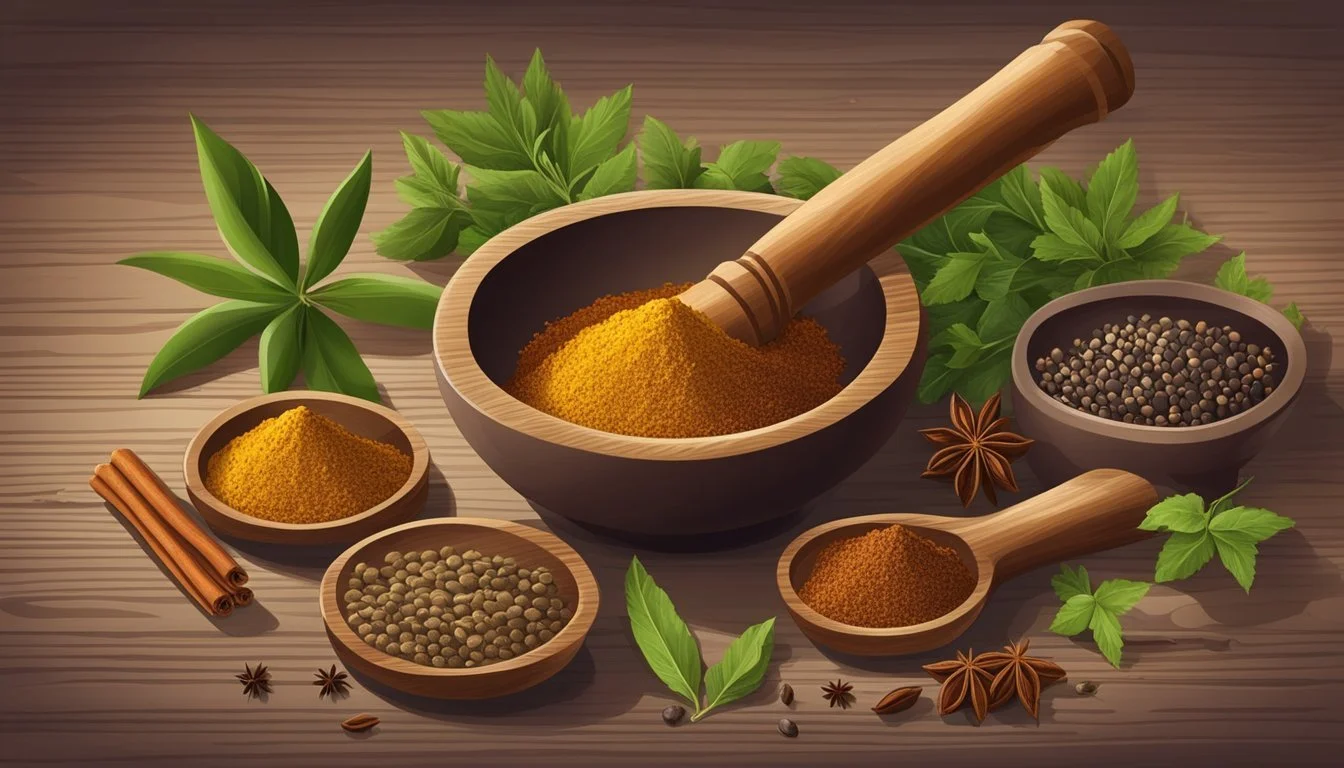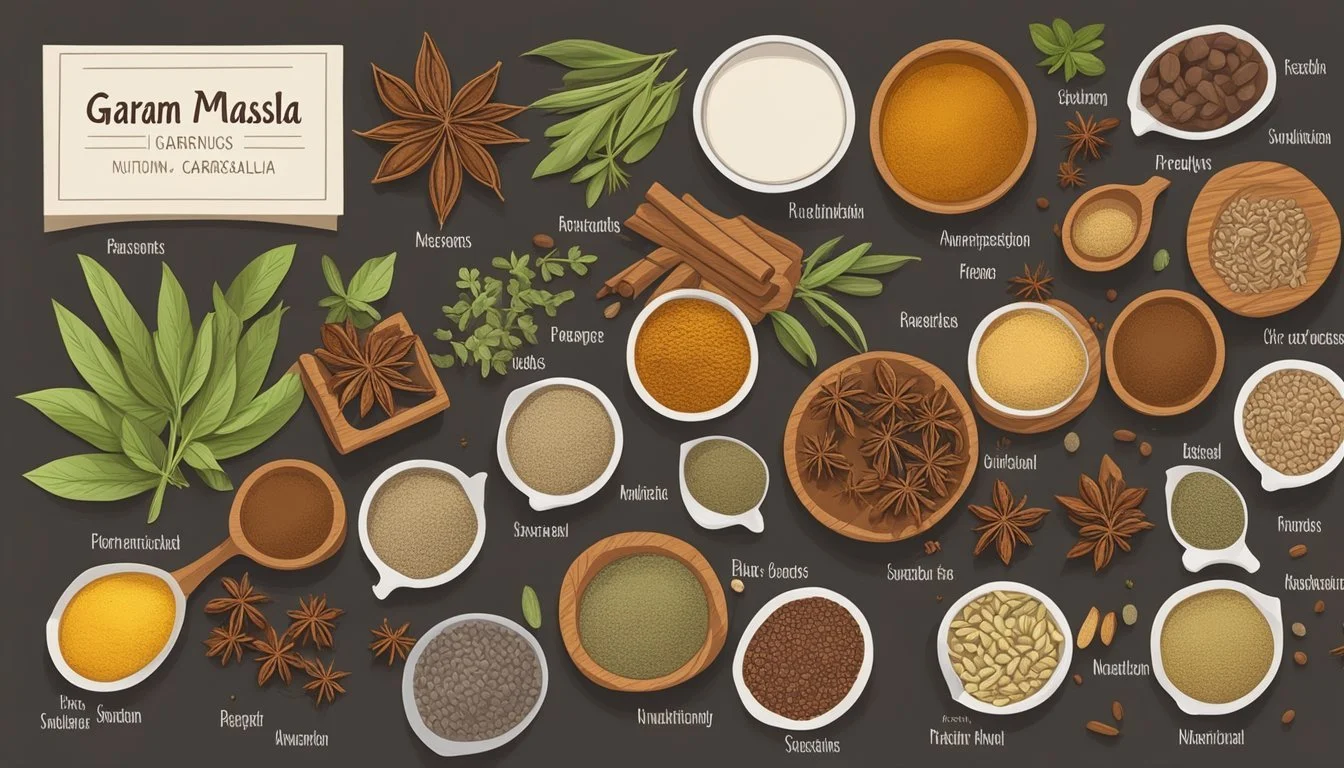Garam Masala Substitutes
Top Alternatives for Your Spice Mix
Garam Masala is an essential component of Indian cuisine, known for its ability to impart warmth and depth to dishes. The term itself translates to 'warm spice mix', and its composition is a testament to the rich culinary heritage of India. It is a blend of several spices such as cardamom, cumin, coriander, cloves, cinnamon, nutmeg, and others that vary by region and personal preference. A hallmark of Garam Masala is its versatility; it can enhance savory and sweet dishes alike, providing an intricate balance of flavors that is both complex and comforting.
However, there are times when Garam Masala is not readily available or when home cooks want to venture into creating similar taste profiles using different ingredients. Fortunately, the distinctive flavors of Garam Masala can be mimicked using substitutes that maintain the integrity of the dish. Substitutes may include common household spices or other spice blends that share overlapping components with Garam Masala. These alternatives can provide a similar warmth and complexity, ensuring that the essence of the dish remains true to its roots even when adaptations are made.
Understanding the fundamental spices that make up Garam Masala helps in selecting the appropriate substitutes. Spices like coriander, cumin, and cardamom serve as sound starting points for crafting an alternative blend. The key to an effective substitution lies in the balance of these spices, ensuring they come together harmoniously to closely match the flavor profile of traditional Garam Masala. Whether a recipe calls for a robust heat or a subtle sweetness, there are various ways to replicate the sought-after spice blend using different combinations of readily available spices.
Understanding Garam Masala
Garam Masala, a staple in Indian cuisine, is celebrated for its complexity of flavors and aromatic richness. Its formulation varies regionally but revolves around a core set of spices.
Key Components and Flavors
Garam Masala typically combines several spices, each contributing to its overall profile. These key ingredients usually include:
Cardamom: Contributes a sweet, floral aroma.
Coriander: Offers a citrusy, nutty flavor.
Black Peppercorns: Add sharpness and heat.
Cloves: Impart a strong, pungent flavor.
Cumin: Delivers an earthy, warming note.
Cinnamon: Provides sweetness and woodiness.
The resulting blend is noted for warming spices that bring about a multi-layered taste experience with distinct aromas and a rich depth of flavor.
The Role in Indian Cooking
In Indian cooking, Garam Masala is a focal point in the creation of many dishes. It is frequently used as:
A finishing spice to enhance aroma just before serving.
A seasoning in marinades.
A foundational flavoring during the cooking process.
It elevates vegetarian and meat dishes alike, integrating into the fabric of curries, stews, and rice dishes to intensify both flavor and aroma.
Health and Nutritional Aspects
The spices in Garam Masala are not just flavorful, they are also associated with health benefits rooted in Ayurvedic medicine. These ingredients are believed to possess therapeutic properties, such as aiding digestion and boosting immunity. The blend is also devoid of calories, making it a health-conscious addition to meals.
Homemade Garam Masala Techniques
To craft Garam Masala at home, one may employ techniques that ensure a potent flavor:
Toast the whole spices (cardamom, coriander, cloves, etc.) over low heat to augment their aroma and flavor.
Cool the roasted spices to retain essential oils and aromatics.
Grind the cooled spices into a fine powder, which can then be stored in an airtight container to maintain its potency.
Home cooks often adjust the proportions of spices to cater to personal preferences, allowing for a custom blend that complements their cooking style.
Common Garam Masala Substitutes
Finding a suitable replacement for garam masala is helpful for cooks looking to replicate the distinctive flavor profile of this spice blend when it is unavailable. The following substitutes maintain the integrity of the original dish's palate while offering the flexibility to accommodate variations in spice availability or taste preference.
Substitute Blends in Indian Cuisine
Curry Powder: A reliable substitute, curry powder contains many of the same spices found in garam masala, including turmeric, which lends a vibrant color and a slightly different but warm flavor profile.
Chaat Masala: This blend, although more tangy due to the inclusion of amchoor (dried mango powder), can mimic the multifaceted taste of garam masala in many dishes, especially those requiring a sour note.
Sambar Masala: Used primarily in South Indian cuisine, sambar masala can serve as a garam masala substitute with its complex, peppery flavor.
Individual Spice Substitutes
Allspice: Alone, it can imitate the warm tones of garam masala, given its mixture of cloves, cinnamon, and nutmeg-like flavors.
Nutmeg and Black Pepper: A combination of freshly ground nutmeg and black pepper can closely approach the spice undertones of garam masala.
Ras el Hanout: While a North African blend, it contains many spices common in garam masala and can be a suitable alternative with its rich, warm flavors.
Pumpkin Spice: Sharing cinnamon and nutmeg, it can be a fall-inspired substitute, primarily in sweet dishes.
Using Substitutes in Recipes
When using substitutes for Garam Masala in recipes, it's crucial to tailor the replacement spices to maintain the intended flavor profile and aroma complexity characteristic of the original spice blend.
Adjusting Flavors and Aromas
Curries and Stews: In dishes like curries and stews that rely heavily on Garam Masala, one can opt for a blend of cumin, coriander, and ground black peppercorns to mimic the earthy tones and warmth. For added depth, a touch of ground cinnamon can bring a subtle sweetness.
Table 1: Flavor Adjustment for Curries and Stews
Original Spice Substitute Ratio Notes Garam Masala 1 tbsp Standard measure in recipes Cumin 1 tsp Provides warmth and earthiness Coriander 1 tsp Contributes to a slightly citrusy note Black Peppercorns 1/2 tsp, ground Adds a sharp, piquant flavor Cinnamon 1/2 tsp Infuses sweetness and warmth
Considerations for Specific Dishes
Chicken Tikka Masala and Butter Chicken: For these rich, tomato-based dishes, a combination of cinnamon, fenugreek, and cloves creates a balance of sweetness and bitterness, complementing the creamy texture.
Lentils and Aloo Gobi: These vegetarian dishes (What wine goes well with vegetarian dishes?) benefit from the savory notes of cumin and coriander. The addition of ground red chiles can replicate Garam Masala's heat, while fenugreek can introduce subtle complexity.
Ratio and Proportion Variations
Different recipes require unique approaches when adjusting substitute ratios. For instance:
For a standard powder-based spice blend as a Garam Masala substitute, begin with lesser quantities, as substitute blends may have more concentrated flavors.
List 1: Proportion Guidelines
General Guideline: 2 teaspoons of the substitute blend for every 1 tablespoon of Garam Masala required.
For more heat: Increase proportions of ground red chiles or black peppercorns.
Aromatic intensity: Cloves and cardamom are aromatic powerhouses; use sparingly to not overwhelm the dish's profile.
Using these guidelines, cooks can confidently experiment with alternative spice combinations to achieve a comparable taste and fragrance as Garam Masala in an array of dishes.
Creating Your Own Garam Masala Substitute
Creating a substitute for Garam Masala at home can be straightforward with the right spices. This section provides clear instructions on making a DIY blend and choosing the appropriate spices to match the warm, complex flavors of traditional Garam Masala.
DIY Blend Instructions
For a basic Garam Masala substitute, home cooks need just a few common spices from their pantry. Start by gathering cumin seeds, coriander seeds, and green cardamom pods. For a tablespoon of Garam Masala, use the following ratio:
Cumin Seeds: 1 teaspoon
Coriander Seeds: 2 teaspoons
Green Cardamom Pods (seeds only): 1/2 teaspoon
The process is as follows:
Toast the spices in a dry pan over low heat until fragrant, about 1 minute, to enhance their flavors. One must be vigilant to prevent burning.
Allow the spices to cool completely.
Grind the mixture using a spice grinder or a mortar and pestle to a fine powder for use in various recipes.
Selecting Spices for Custom Blends
When it comes to customizing a Garam Masala substitute, chefs can select additional spices based on their specific flavor profiles. Potential additions include:
Bay Leaves: for a subtle, herbal note
Fennel Seeds: for a sweet, anise-like quality
Mustard Seeds: for a spicy, pungent kick
Coconut (desiccated): for a sweet, nutty flavor, albeit less traditional
A well-stocked pantry allows for experimentation with spice blends. The key is to maintain a balance of warm, sweet, and earthy tones that Garam Masala is known for. Chefs should proportion their spices to taste, keeping in mind that flavors such as cardamom, nutmeg, and cloves can be quite potent.
When grinding homemade spice blends, achieving a fine, even consistency is crucial for the best integration of flavors into dishes. To store, place the resulting powder in an airtight container, and keep it in a cool, dark place to preserve its potency.
Shopping for Garam Masala Alternatives
When seeking alternatives to Garam Masala, shoppers should focus on finding spices that offer similar warmth and flavor profiles. Knowing where to look and understanding regional spice variations are key.
Locating Substitutes in the Grocery Store
Grocery stores often organize spices by cuisine or alphabetically. In the Indian or Asian section, one can find spices that are components of Garam Masala, like:
Cardamom
Cumin
Cloves
Cinnamon
When Garam Masala is unavailable, there are single-spice substitutes or combinations that can mimic its complex flavor. For instance, curry powder serves as an easy substitute due to its availability and complementary blend of spices.
Understanding Regional Variations
Garam Masala is a Northern Indian spice blend that varies by region, which influences the substitutes available. In Northern India, Garam Masala tends to be milder and emphasizes aromatic spices. Shoppers should know that the warmth and sweetness in Garam Masala are typically derived from spices like cinnamon and cloves.
Regional blends may adjust the heat or include unique spices such as fennel or fenugreek, affecting the overall flavor. When choosing a substitute, it's important to consider the desired flavor profile and how it will integrate with the other ingredients in the recipe.
Nutritional Information and Dietary Considerations
When considering Garam Masala substitutes, it's important to be mindful of their nutritional profiles and how they adhere to various dietary restrictions. This section outlines the calories and macronutrient breakdown of different spice blends, as well as suitable alternatives for special diets.
Calories and Macronutrient Profiles
Garam Masala is typically low in calories, and contains negligible amounts of fat, sodium, and carbohydrates. Its components—a mix of spices such as cardamom, coriander, cumin, and cinnamon—contribute mainly to its flavor rather than caloric content. Here is a general nutritional breakdown of a teaspoon (approximately 2 grams) of Garam Masala:
Calories: 6
Fat: 0.2g
Sodium: 1mg
Carbohydrates: 1.1g
Fiber: 0.7g
Protein: 0.2g
Substitutes may have similar macronutrient profiles, but the exact figures can vary based on the specific spices used in the alternative spice blend.
Substitutes for Special Diets
Individuals with specific dietary needs can consider several Garam Masala substitutes:
Low-Sodium Diets: Instead of pre-made blends that may contain added salt, one can assemble a homemade mix of ground spices to control the sodium content.
Low-Carb or Keto Diets: Most individual spices in a Garam Masala blend are suitable for low-carb diets. However, watch out for spice mixes that add fillers such as starches or sugars.
Gluten-Free Diets: Pure spice blends without any additives should naturally be gluten-free. Always check labels for certification or potential cross-contamination warnings.
Vegan and Vegetarian Diets: Garam Masala and its direct substitutes are typically vegan and vegetarian, being composed solely of plant-derived spices.
Substitutes for Garam Masala should also be chosen based on a person’s individual tolerance to spicy foods, as some blends may be hotter or contain allergens like nuts or seeds.






